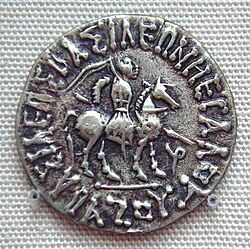Azes I
| Azes I | |
|---|---|
| Indo-Scythian king | |
 Coin of Azes I. Obv: Azes I in military dress, on a horse, with couched spear. Greek legend: ΒΑΣΙΛΕΩΣ ΒΑΣΙΛΕΩΝ ΜΕΓΑΛΟΥ ΑΖΟΥ "of the Great King of Kings Azes". British Museum. | |
| Reign | c. 48/47 – 25 BCE |
| Predecessor | Spalirises |
| Successor | Azilises |
Azes I (Greek: Azēs (IAST: Azēs)
, epigraphically
Azou (IAST: Azou)
; Kharosthi: '
A-ya (IAST: A-ya)
,
Aya (IAST: Aya)
;[1] both from Saka , meaning "leader".[2]) was an Indo-Scythian ruler who ruled around c. 48/47 BCE – 25 BCE[3] and completed the domination of the Scythians in northwestern India.
History[edit]
Maues and his successors had conquered the areas of Gandhara, as well as the area of Mathura from 85 BCE forming the Northern Satraps.
The Azes Era[edit]
Azes's most lasting legacy was the foundation of the Azes era. It was widely believed that the era was begun by Azes's successors by simply continuing the counting of his regnal years. However, Prof. Harry Falk has recently presented an inscription at several conferences which dates to Azes's reign, and suggests that the era may have been begun by Azes himself. Most popular historians date the start of the Azes era to 58 BC and believe it is the same as the later era known as the Malwa or Vikrama era.[4]
However, a recently discovered inscription, the Bajaur reliquary inscription, dated in both the Azes and the Greek era suggests that actually this is not the case. The inscription gives the relationship Azes = Greek + 128. It is believed that the Greek era may have begun in 173 BCE, exactly 300 years before the first year of the Era of Kanishka. If that is the case then the Azes era would begin in about 45 BC.[5]
Azes I and Azes II identical?[edit]
According to Senior, Azes I may have been identical with Azes II, due to the discovery of an overstrike of the former over the latter.[6]
See also[edit]
Notes[edit]
- ↑ Gardner, Percy (1929). The Coins of the Greek and Scythic Kings of Bactria and India in the British Museum. London: Gilbert & Rivington Ltd. pp. 73-92. ISBN 978-0-900-83452-3.
- ↑ Harmatta, János (1999). "Languages and scripts in Graeco-Bactria and the Saka Kingdoms". In Harmatta, János; Puri, B. N.; Etemadi, G. F. (eds.). History of civilizations of Central Asia. Vol. 2. Delhi: Motilal Banarsidass Publishing House. p. 409. ISBN 978-8-120-81408-0.
- ↑ Falk and Bennett (2009), pp. 197–215.
- ↑ Richard Salomon (1998). Indian Epigraphy: A Guide to the Study of Inscriptions in Sanskrit, Prakrit, and the Other Indo-Aryan Languages. Oxford University Press. pp. 182–183, 194–195. ISBN 978-0-19-509984-3.
- ↑ For discussions refer to Bracey, R. (2005) 'The Azes Era' (http://www.kushan.org/essays/chronology/azesvikrama.htm), Cribb, J (2005) 'The Greek Kingdom of Bactria, its coinage and collapse' in Afghanistan, Ancien Carrefour entre l'est et l'ouest (ed. Bopearachichi O & Boussac, M-F), Turnhout: 207–225, Falk, H. & C. J. Bennett 'Macedonian Intercalary Months and the Era of Azes' Acta Orientalia 70 (2009) 197–216
- ↑ Coin India
References[edit]
- Harry Falk and Chris Bennett (2009). "Macedonian Intercalary Months and the Era of Azes". Acta Orientalia (70): 197–215. ISSN 0001-6438. Retrieved 11 April 2014.
- McEvilley, Thomas (2002). The Shape of Ancient Thought. Comparative studies in Greek and Indian Philosophies. Allworth Press and the School of Visual Arts. ISBN 978-1-58115-203-6. Retrieved 11 April 2014.
- W.W. Tarn (2010). The Greeks in Bactria and India. Cambridge University Press. ISBN 978-1-108-00941-6. Retrieved 11 April 2014.
External links[edit]
| Preceded by Spalirises (Indo-Scythian king) |
Indo-Scythian Ruler 57 – 35 BCE |
Succeeded by Azilises |
| Preceded by Telephos (Indo-Greek king in Arachosia and Gandhara) | ||
| Preceded by Hippostratos (Indo-Greek king in Western Punjab) |
|
